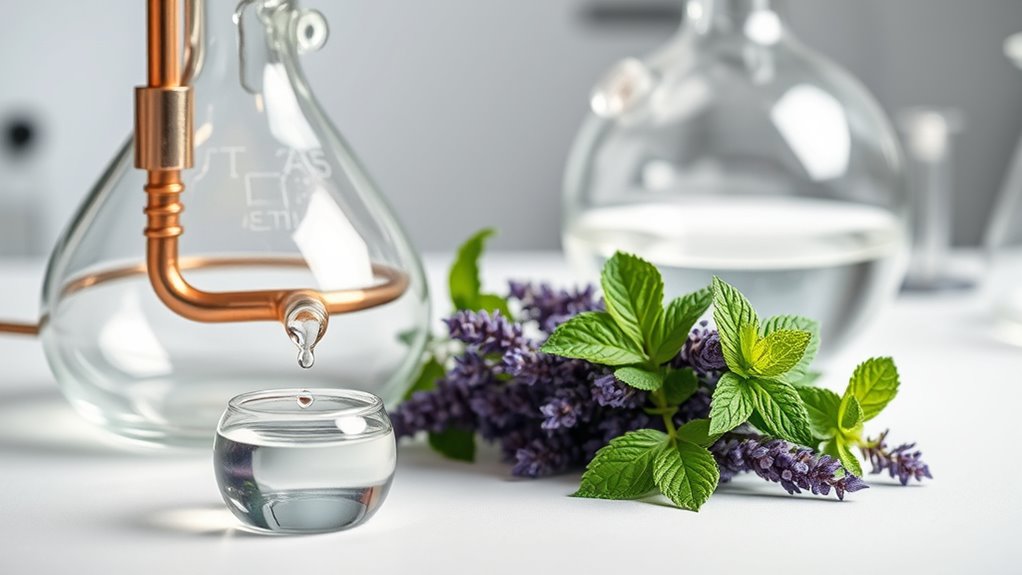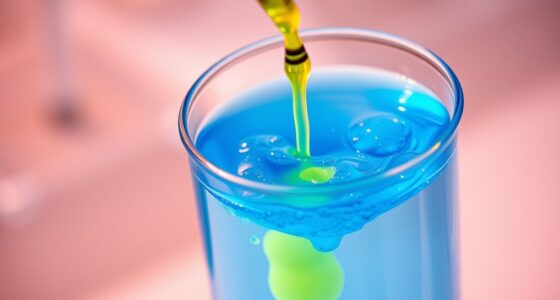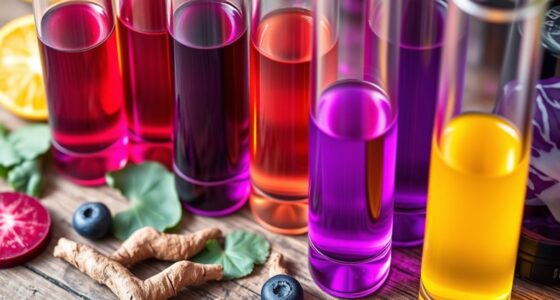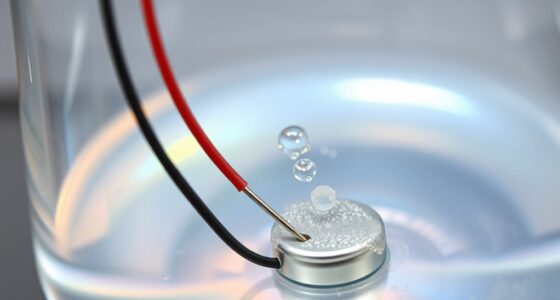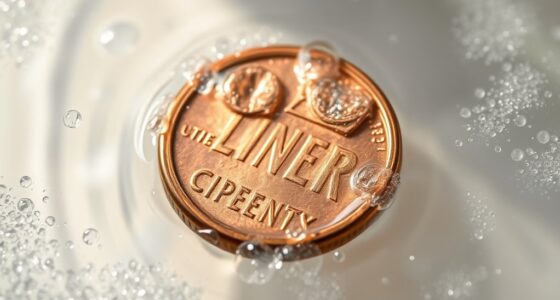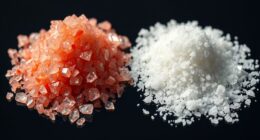To extract essential oils chemically, you can use techniques like steam distillation or supercritical CO₂ extraction. In steam distillation, you pass steam through plant material to vaporize the oils, then condense them. Supercritical CO₂ uses high pressure and temperature to pull out volatile compounds efficiently without residues. Solvent extraction with ethanol or hexane is another method, but safety and purity depend on proper chemical handling. Explore further to master optimizing conditions and ensuring quality.
Key Takeaways
- Select suitable extraction methods such as steam distillation, hydrodistillation, or supercritical CO₂ based on target compounds and efficiency.
- Control temperature and pressure conditions carefully to maximize yield while preserving chemical integrity of volatile components.
- Use appropriate solvents (e.g., ethanol, hexane, or CO₂) considering polarity, safety, and environmental impact to extract specific compounds.
- Employ analytical techniques like GC-MS and HPLC to verify chemical composition and ensure extract purity and consistency.
- Follow safety protocols during extraction, including proper equipment handling, contamination prevention, and safe storage of essential oils.
Understanding the Role of Temperature and Pressure in Oil Extraction
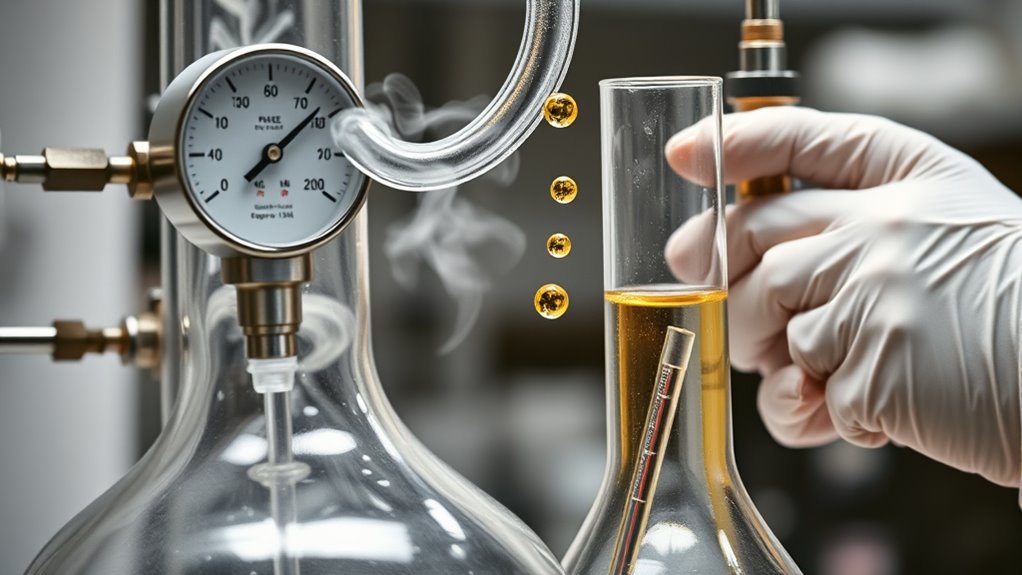
Understanding how temperature and pressure influence oil extraction is vital for optimizing yield and quality. Higher temperatures generally boost liquid yields by increasing solubility, but excessive heat can degrade sensitive compounds, changing the oil’s therapeutic properties. Each plant requires specific temperature ranges; for example, marjoram extraction occurs between 293.15–313.15 K. In steam distillation, operating at around 100°C vaporizes volatile compounds without combustion. Pressure also plays a key role: increasing pressure enhances solvent density, improving extraction efficiency—supercritical CO₂ at 100–200 bar is ideal for marjoram. It can also lower boiling points, aiding delicate materials like citrus. Additionally, understanding compound stability during extraction helps prevent the breakdown of key aromatic components. Recognizing the importance of factors influencing extraction allows for more precise control over the process, ensuring higher quality oils. Properly managing extraction parameters can also reduce the co-extraction of undesired compounds, leading to purer extracts. Carefully balancing temperature and pressure guarantees maximum yield while preserving the oil’s chemical integrity. Developing a thorough understanding of these factors can enhance cultural intelligence when applying extraction techniques across different cultural contexts. Moreover, considering extraction methods tailored to specific plant materials can further optimize the process for desired outcomes.
Comparing Steam Distillation and Hydrodistillation Techniques

Have you ever wondered how different extraction methods impact the quality and quantity of essential oils? Both steam distillation and hydrodistillation are popular techniques, but they differ markedly. Steam distillation uses steam to vaporize oils, often producing higher-quality oils with better biological properties, like antimicrobial and antioxidant activity. It can retrieve a broader range of compounds and maintain their integrity. Additionally, understanding the cultural impact of extraction methods can help optimize processes for different types of plant materials. Moreover, the creative practice involved in refining these methods can lead to innovations that enhance oil purity and efficiency. Hydrodistillation, on the other hand, submerges plant material in water, which sometimes yields slightly more oil but may compromise some qualities. It’s simpler and faster when steam isn’t available. Equipment setups also differ: steam distillation requires a steam generator, while hydrodistillation needs only boiling water. Your choice depends on the desired oil quality, yield, and available resources. Considering traditional practices can also influence the selection of extraction techniques to preserve authentic flavors and properties. Furthermore, environmental factors play a significant role in oil composition, affecting the efficiency and sustainability of each method.
Leveraging Supercritical CO2 for High-Quality Extracts

Supercritical CO2 extraction harnesses CO2’s unique properties when subjected to specific temperature and pressure conditions, turning it into a highly effective solvent for extracting essential oils. By surpassing its critical point (above 31.1°C and 74 bar), CO2 becomes a tunable solvent with adjustable polarity, efficiently dissolving non-polar to moderately polar compounds. Its gas-like viscosity allows it to penetrate dense plant tissues more thoroughly than traditional liquids, increasing yield. Because it operates in a closed system, there’s no oxygen exposure, preserving sensitive terpenes and sesquiterpenes. The process is environmentally friendly, leaving no toxic residues and reducing waste. With precise control over parameters like pressure and temperature, you can target specific compounds, ensuring high-quality, full-spectrum extracts that retain volatile aromatics and maintain stability. Additionally, understanding the vetted safety considerations ensures the process remains both effective and safe for high-quality extraction. Moreover, the ability to selectively extract certain compounds enhances the purity and potency of the final product. Incorporating chemistry principles allows for optimization of extraction conditions, leading to more consistent and desirable outcomes. Utilizing advanced analytical techniques can further refine the process, ensuring the highest purity and efficacy of the extracts.
Exploring Solvent Extraction Methods and Their Chemical Implications
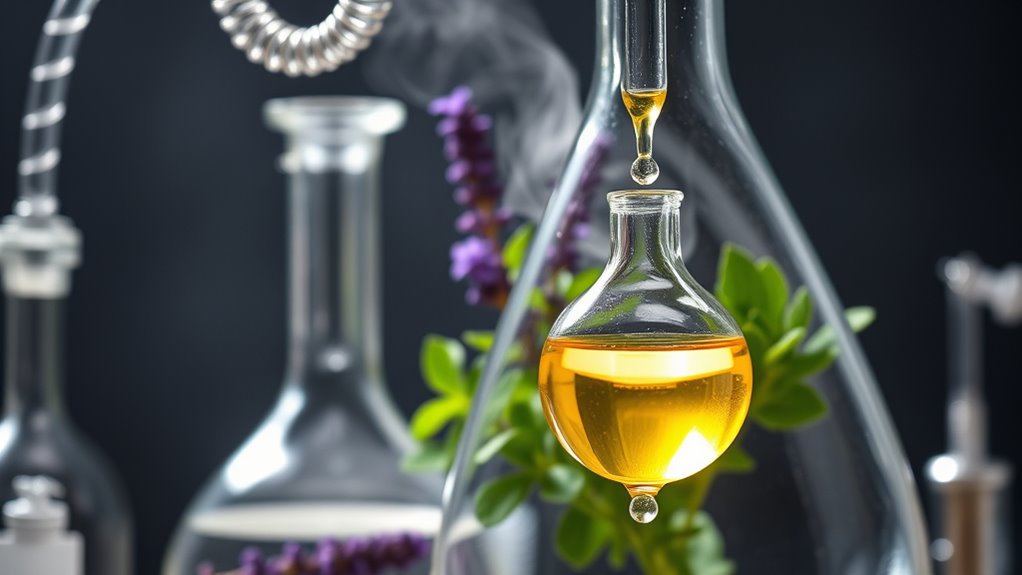
Exploring solvent extraction methods reveals how the choice of solvent and technique directly influences the chemical composition and quality of essential oil extracts. You’ll find common solvents like ethanol, hexane, and supercritical CO2, with ethanol and hexane favored for their cost efficiency. Techniques such as maceration and enfleurage target lipophilic compounds, including resins and waxes that water-based methods can’t extract. The efficiency depends on factors like solvent polarity, plant particle size, and extraction time. Chemical implications include potential solvent residues—hexane may leave toxic traces if not fully purged—while CO2 offers a greener alternative. These methods produce concentrated extracts like absolutes, resinoids, and concretes, which are essential in perfumery, flavoring, and pharmaceuticals. Proper understanding ensures high-quality, safe, and targeted essential oil products. Additionally, understanding the significance of solvent polarity can help optimize extraction efficiency and chemical stability of the final product. Recognizing the impact of solvent residues is crucial for ensuring safety and purity in the final extracts. An awareness of potential safety concerns related to residual solvents helps in developing safer extraction processes. Being aware of AI vulnerabilities such as bias and jailbreak techniques can also inform safety practices in the development of extraction technologies.
Equipment Requirements and Safety Considerations in Essential Oil Extraction
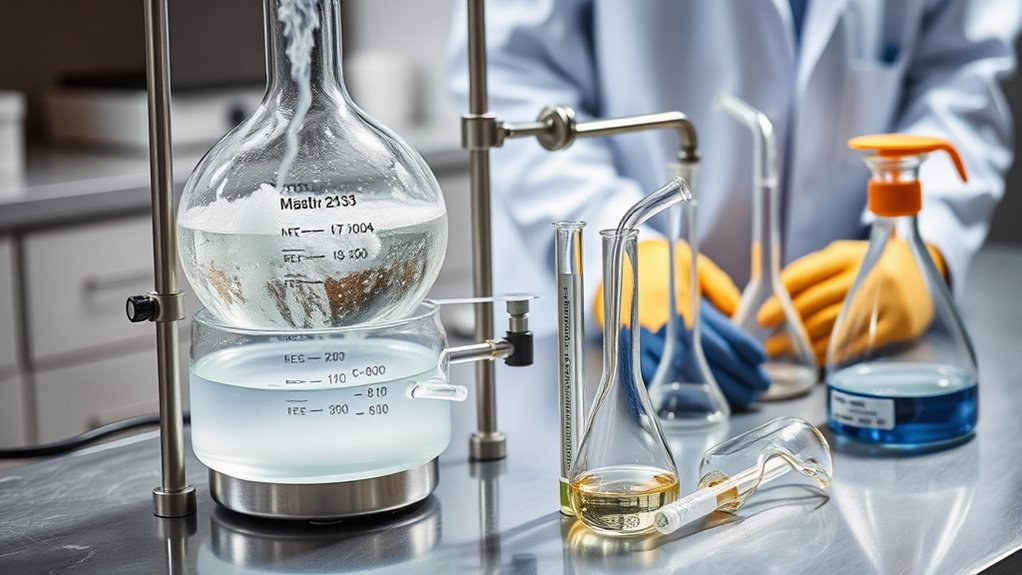
To guarantee successful essential oil extraction, you need to carefully select and set up the appropriate equipment while prioritizing safety. Use sharp knives and cutters to prepare plant material efficiently. Accurate measurements require graduated cylinders, pipettes, and scales. For distillation, set up glass apparatus with borosilicate glass, including flasks, condensers, and clamps to prevent leaks. Store oils in amber or cobalt-blue bottles with tight lids to prevent light degradation. Always wear nitrile gloves, eye protection, and heat-resistant gloves to guard against chemicals, heat, and splashes. Conduct distillation in a well-ventilated area, and keep fire safety equipment nearby due to flammable solvents. Regularly inspect equipment and storage containers for cracks or leaks, ensuring a safe, contamination-free extraction process. Proper equipment maintenance is essential to maintain safety and ensure high-quality oil yields. Additionally, understanding the chemical properties of the solvents used can help optimize extraction efficiency and safety. Being aware of the history of pinball machines can also inspire innovative approaches to designing extraction setups that mimic traditional methods.
Ensuring Purity and Consistency in Extracted Oils
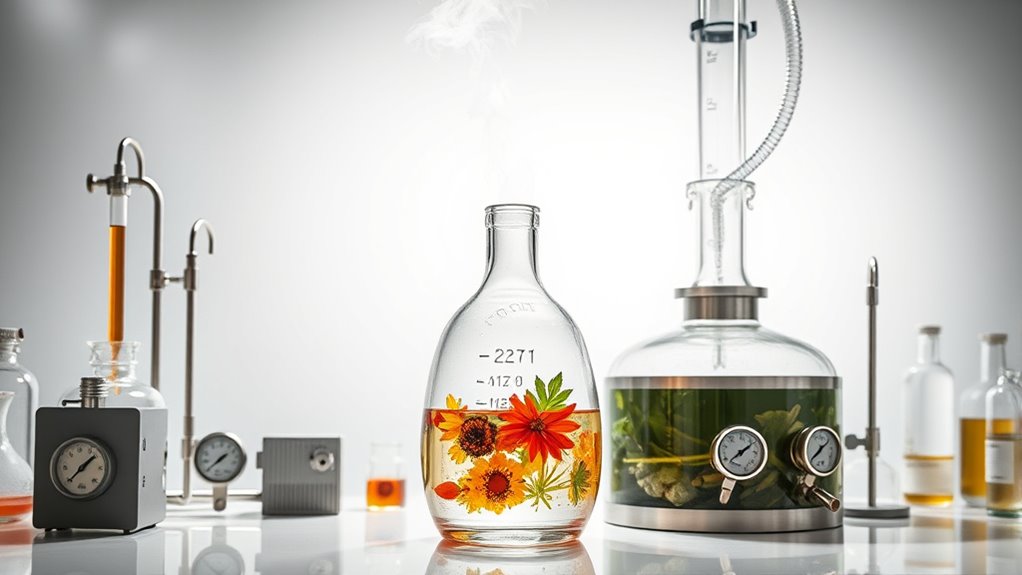
Ensuring purity and consistency in extracted essential oils is essential for producing high-quality products that meet safety and efficacy standards. You should start with high-quality plant materials, as this directly impacts the oil’s purity. Optimizing extraction conditions—such as temperature, pressure, and duration—helps preserve the oil’s chemical integrity. Proper storage in dark bottles at cool temperatures prevents degradation and maintains consistency over time. Regular batch testing using techniques like GC-MS and HPLC verifies the oil’s chemical composition, confirming uniformity across production. Sensory evaluations, such as organoleptic testing, can detect potential contaminants or adulteration. Adhering to regulatory standards and documenting your processes guarantees safety and authenticity. Consistent quality control practices ultimately guarantee that your essential oils remain pure, reliable, and safe for consumers.
Environmental and Cost Factors in Choosing an Extraction Method
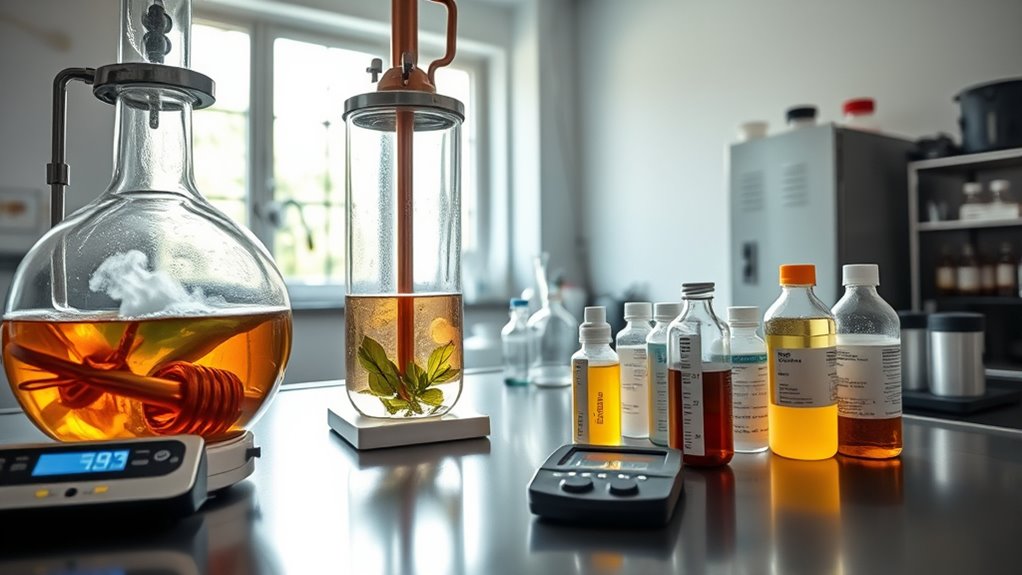
Choosing an extraction method involves balancing environmental impact and cost considerations to achieve sustainable and efficient production. You should evaluate how methods affect ecosystems—traditional techniques can cause deforestation, habitat loss, soil degradation, water pollution, and increased CO2 emissions. Eco-friendly options like CO2 extraction minimize environmental harm, but they require significant initial investment. Operating costs differ: steam distillation is cheaper but consumes more water and energy, while microwave-assisted hydrodistillation (MWHD) offers energy efficiency. Sustainable sourcing and organic farming help reduce ecological damage, protecting biodiversity. Although some methods are cost-effective upfront, high-quality oils from CO2 extraction often justify the investment through better yield and purity. Ultimately, choosing an extraction process depends on balancing environmental responsibility with economic viability for your operation.
Frequently Asked Questions
How Does Plant Type Influence the Choice of Extraction Method?
You see that plant type directly affects your extraction method. For lipid-rich plants like citrus peels, solvent extraction works best. If you work with delicate, thermally sensitive plants like mint, cold solvents or supercritical fluid extraction prevent degradation. Dense, woody tissues need prolonged hydrodistillation, while thin, volatile structures like lavender benefit from steam distillation. Your choice depends on tissue structure, chemical composition, and practical factors like equipment and cost.
What Are the Signs of Thermal Degradation in Essential Oils?
When you notice a change in your essential oil, it’s often a sign of thermal degradation. Look for color shifts, like darkening or cloudiness, and viscosity changes, such as thickening or separation. Smell for off-putting, sour, or rancid odors, and taste for bitterness. These physical and sensory clues indicate that heat has broken down the compounds, reducing the oil’s quality and therapeutic properties.
Can Essential Oils Be Extracted From Dried Versus Fresh Plant Material?
You can extract essential oils from both dried and fresh plant materials. Fresh plants offer higher volatile compounds and are ideal for methods like cold pressing and enfleurage. Dried plants provide concentrated, stable inputs suitable for steam distillation and solvent extraction, with shorter processing times and increased shelf life. Your choice depends on the desired oil quality, extraction method, and practical factors like cost, storage, and seasonal availability.
How Do Extraction Methods Impact the Therapeutic Properties of Oils?
You need to ensure how your chosen extraction method affects the therapeutic properties of your oils. Techniques like cold pressing or supercritical CO₂ preserve sensitive compounds, maintaining bioactivity. Conversely, high-temperature methods like steam distillation or hydrodistillation can degrade key bioactives, reducing efficacy. Solvent choice also influences therapeutic ratios by selectively extracting certain compounds, so selecting the right method guarantees you retain the oils’ full health benefits.
What Are the Safety Precautions for Handling High-Pressure CO2 Equipment?
Did you know that improper handling of high-pressure CO2 equipment can cause accidents? You must follow safety protocols, like certifying pressure-rated equipment, regularly testing for leaks, and using automatic relief valves. Always wear PPE, including goggles, gloves, and respiratory masks if needed. Keep ventilation adequate, label chemicals properly, and stay trained on emergency procedures. These precautions protect you from risks like frostbite, asphyxiation, or equipment failure during operation.
Conclusion
By mastering the chemistry behind essential oil extraction, you hold the key to revealing nature’s hidden treasures. Think of each method as a different brushstroke on your canvas—steam, supercritical CO2, solvents—all painting a picture of purity and potency. As you choose your tools wisely, you become a skilled alchemist, transforming raw plant matter into liquid gold. With careful control and knowledge, you’ll craft oils as pure and vibrant as a sunrise in a bottle.
